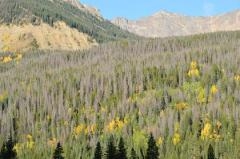Mountain Pine Beetle Epidemic

The mountain pine beetle is a species of bark beetle native to the forests of western North America from Mexico to central British Columbia. It has a hard black exoskeleton, and measures about 5 mm, about the size of a grain of rice. Mountain pine beetles inhabit ponderosa, Scotch and limber pine trees. Normally, these insects play an important role in the life of a forest, attacking old or weakened trees, and speeding development of a younger forest. A new University of Colorado Boulder study shows for the first time that episodes of reduced precipitation in the southern Rocky Mountains, especially during the 2001-02 drought, greatly accelerated development of the mountain pine beetle epidemic.
While the 2001-02 drought in the West played a key role in pushing
the pine beetle outbreak into a true regional epidemic, the outbreak
continued to gain ground even after temperature and precipitation levels
returned to levels nearer the long-term averages, said Chapman of
CU-Boulder’s geography department. The beetles continued to decimate
lodgepole pine forests by moving into wetter and higher elevations and
into less susceptible tree stands -- those with smaller diameter
lodgepoles sharing space with other tree species.
"In recent years some researchers have thought the pine beetle outbreak
in the southern Rocky Mountains might have started in one place and
spread from there," said Chapman. "What we found was that the mountain
pine beetle outbreak originated in many locations. The idea that the
outbreak spread from multiple places, then coalesced and continued
spreading, really highlights the importance of the broad-scale drivers
of the pine beetle epidemic like climate and drought."
Mountain pine beetles are native insects that have shaped the forests of
North America for thousands of years. They range from Canada to Mexico
and are found at elevations from sea level to 11,000 feet. The effects
of pine beetles are especially evident in recent years on Colorado’s
Western Slope, including Rocky Mountain National Park, with a
particularly severe epidemic occurring in Grand and Routt counties.
Mountain pine beetles affect pine trees by laying eggs under the bark.
The beetles introduce blue stain fungus into the sapwood that prevents
the tree from repelling and killing the attacking beetles with tree
pitch flow. The fungus also blocks water and nutrient transport within
the tree. On the tree exterior, this results in popcorn-shaped masses of
resin, called pitch tubes, where the beetles have entered. The joint
action of larval feeding and fungal colonization kills the host tree
within a few weeks of successful attack (the fungus and feeding by the
larvae girdles the tree, cutting off the flow of water and nutrients).
When the tree is first attacked, it remains green. Usually within a year
of attack, the needles will have turned red. This means the tree is
dying or dead, and the beetles have moved to another tree. In three to
four years after the attack, very little foliage is left, so the trees
appear grey.
Chapman said the most recent mountain pine beetle outbreak began in the
1990s, primarily in scattered groups of lodgepole pine trees living at
low elevations in areas of lower annual precipitation. Following the
2001-02 drought, the outbreak was uncoupled from the initial weather and
landscape conditions, triggering a rise in beetle populations on the
Western Slope and propelling the insects over the Continental Divide
into the northern Front Range to infect ponderosa pine, Chapman said.
The current pine beetle epidemic in the southern Rocky Mountains was
influenced in part by extensive forest fires that ravaged Colorado’s
Western Slope from roughly 1850 to 1890, said Chapman. Lodgepole pine
stands completely burned off by the fires were succeeded by huge swaths
of seedling lodgepoles that eventually grew side by side into dense
mature stands, making them easier targets for the pine beetles.
"The widespread burning associated with dry years in the 19th century
set the stage for the current outbreak by creating vast areas of trees
in the size classes most susceptible to beetle attack," said Chapman.
Veblen said a 1980s outbreak of the pine beetle centered in Colorado’s
Grand County ended when extremely low minimum temperatures were reached
in the winters of 1983 and 1984, killing the beetle larvae. But during
the current outbreak, minimum temperatures during all seasons have been
persistently high since 1996, well above the levels of extreme cold
shown to kill beetle larvae in laboratory experiments.
"This implies that under continued warming trends, future outbreaks will
not be terminated until they exhaust their food supply -- the pine tree
hosts," said Veblen.
Veblen said while the rate of spread of the mountain pine beetle in
lodgepole pine forests has declined in the southern Rocky Mountains
during the past two years because of a depletion of host pine
population, U.S. Forest Service surveys indicate the rate of beetle
spread in ponderosa pine forests on the Front Range has increased
sharply over the past three years. "The current study suggests that
under the continued warmer climate, the spread of the beetle in
ponderosa pines is likely to grow until that food source also is
depleted," Veblen said.
A 2012 study by CU-Boulder Professor Jeffry Mitton and graduate student
Scott Ferrenberg showed some Colorado pine beetles, which had been known
to produce only one generation of tree-killing offspring annually, are
producing two generations per year due to rising temperatures and a
longer annual warm season. Because of the extra annual generation of
beetles, there could be up to 60 times as many beetles attacking trees
in any given year, according to the study.
For further information see
Beetle Epidemic.
Mountains image via University of Colorado.
©2012. Copyright Environmental News Network To subscribe or visit go to: http://www.enn.com